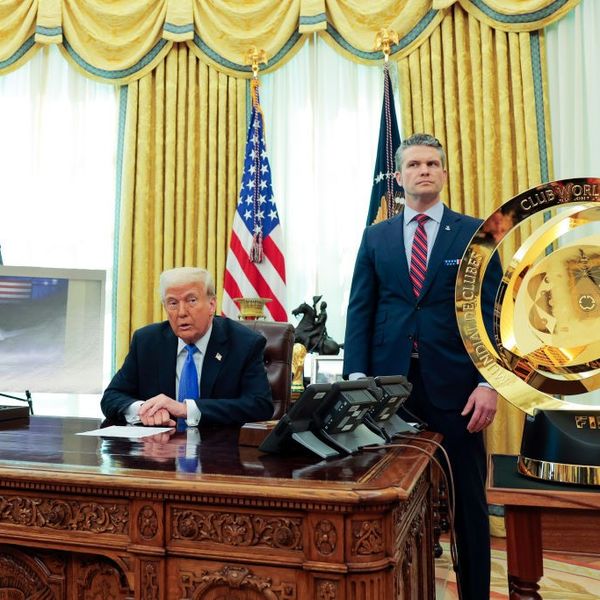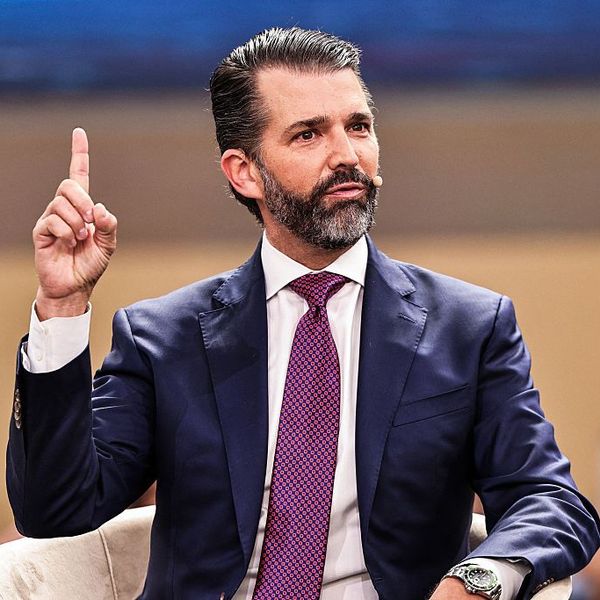They Have 'Propaganda,' US Has 'Public Diplomacy'-and a Servile Private Sector
The New York Times headline (4/15/15) paints a dire picture:
Turmoil at Voice of America Is Seen as Hurting US Ability to Counter Propaganda
But wait a second-isn't Voice of America itself a propaganda outlet? Not in the New York Times stylebook, apparently. The piece, by Ron Nixon, describes VOA as "the government agency that is charged with presenting America's viewpoint to the world." Later on, the Times refers to what it calls "America's public diplomacy."
The US's enemies, on the other hand, have "sophisticated propaganda machines that have expanded the influence of countries like China and Russia and terrorist groups like the Islamic State." The difference between "propaganda machines" and "public diplomacy" is never explained in the article, but the former appears to be what "they" do while the latter is what "we" do.
The only source quoted in the article who's not directly connected to the government is Glen Howard, president of the Jamestown Foundation, described as "a Washington think tank." ("We are getting our butts kicked.... Countries like Russia are running circles around us," Howard says.) Not mentioned is the fact that Jamestown was founded with the help of then-CIA Director William Casey to provide financial support for the Agency's spies (Washington Post, 1/10/05).
The article reports that since the Cold War, which it helped win by "providing unfiltered news to dissidents and countering communist propaganda in the Soviet Union and Soviet-backed countries," VOA has been "pulled between providing credible news and supporting American policy." Congressional Republicans want to
revise the Voice of America's charter to state explicitly that the agency has a role in supporting American "public diplomacy" and countering propaganda from other countries.
In other words, they're insisting that VOA make its news more propagandistic. And the New York Times refers consistently to this goal throughout the article as "countering propaganda."
When you have arguably the US's most prestigious for-profit media outlet describing government propaganda as "efforts to counter propaganda," it's pretty clear that the nation's demand for propaganda is going to be met-whether by the public or the private sector.
An Urgent Message From Our Co-Founder
Dear Common Dreams reader, The U.S. is on a fast track to authoritarianism like nothing I've ever seen. Meanwhile, corporate news outlets are utterly capitulating to Trump, twisting their coverage to avoid drawing his ire while lining up to stuff cash in his pockets. That's why I believe that Common Dreams is doing the best and most consequential reporting that we've ever done. Our small but mighty team is a progressive reporting powerhouse, covering the news every day that the corporate media never will. Our mission has always been simple: To inform. To inspire. And to ignite change for the common good. Now here's the key piece that I want all our readers to understand: None of this would be possible without your financial support. That's not just some fundraising cliche. It's the absolute and literal truth. We don't accept corporate advertising and never will. We don't have a paywall because we don't think people should be blocked from critical news based on their ability to pay. Everything we do is funded by the donations of readers like you. Will you donate now to help power the nonprofit, independent reporting of Common Dreams? Thank you for being a vital member of our community. Together, we can keep independent journalism alive when it’s needed most. - Craig Brown, Co-founder |
The New York Times headline (4/15/15) paints a dire picture:
Turmoil at Voice of America Is Seen as Hurting US Ability to Counter Propaganda
But wait a second-isn't Voice of America itself a propaganda outlet? Not in the New York Times stylebook, apparently. The piece, by Ron Nixon, describes VOA as "the government agency that is charged with presenting America's viewpoint to the world." Later on, the Times refers to what it calls "America's public diplomacy."
The US's enemies, on the other hand, have "sophisticated propaganda machines that have expanded the influence of countries like China and Russia and terrorist groups like the Islamic State." The difference between "propaganda machines" and "public diplomacy" is never explained in the article, but the former appears to be what "they" do while the latter is what "we" do.
The only source quoted in the article who's not directly connected to the government is Glen Howard, president of the Jamestown Foundation, described as "a Washington think tank." ("We are getting our butts kicked.... Countries like Russia are running circles around us," Howard says.) Not mentioned is the fact that Jamestown was founded with the help of then-CIA Director William Casey to provide financial support for the Agency's spies (Washington Post, 1/10/05).
The article reports that since the Cold War, which it helped win by "providing unfiltered news to dissidents and countering communist propaganda in the Soviet Union and Soviet-backed countries," VOA has been "pulled between providing credible news and supporting American policy." Congressional Republicans want to
revise the Voice of America's charter to state explicitly that the agency has a role in supporting American "public diplomacy" and countering propaganda from other countries.
In other words, they're insisting that VOA make its news more propagandistic. And the New York Times refers consistently to this goal throughout the article as "countering propaganda."
When you have arguably the US's most prestigious for-profit media outlet describing government propaganda as "efforts to counter propaganda," it's pretty clear that the nation's demand for propaganda is going to be met-whether by the public or the private sector.
The New York Times headline (4/15/15) paints a dire picture:
Turmoil at Voice of America Is Seen as Hurting US Ability to Counter Propaganda
But wait a second-isn't Voice of America itself a propaganda outlet? Not in the New York Times stylebook, apparently. The piece, by Ron Nixon, describes VOA as "the government agency that is charged with presenting America's viewpoint to the world." Later on, the Times refers to what it calls "America's public diplomacy."
The US's enemies, on the other hand, have "sophisticated propaganda machines that have expanded the influence of countries like China and Russia and terrorist groups like the Islamic State." The difference between "propaganda machines" and "public diplomacy" is never explained in the article, but the former appears to be what "they" do while the latter is what "we" do.
The only source quoted in the article who's not directly connected to the government is Glen Howard, president of the Jamestown Foundation, described as "a Washington think tank." ("We are getting our butts kicked.... Countries like Russia are running circles around us," Howard says.) Not mentioned is the fact that Jamestown was founded with the help of then-CIA Director William Casey to provide financial support for the Agency's spies (Washington Post, 1/10/05).
The article reports that since the Cold War, which it helped win by "providing unfiltered news to dissidents and countering communist propaganda in the Soviet Union and Soviet-backed countries," VOA has been "pulled between providing credible news and supporting American policy." Congressional Republicans want to
revise the Voice of America's charter to state explicitly that the agency has a role in supporting American "public diplomacy" and countering propaganda from other countries.
In other words, they're insisting that VOA make its news more propagandistic. And the New York Times refers consistently to this goal throughout the article as "countering propaganda."
When you have arguably the US's most prestigious for-profit media outlet describing government propaganda as "efforts to counter propaganda," it's pretty clear that the nation's demand for propaganda is going to be met-whether by the public or the private sector.

